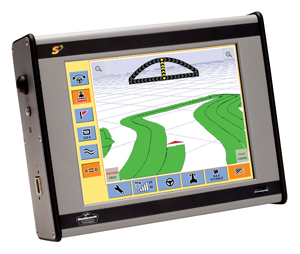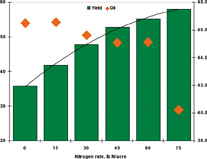
Features
Fertilizer
Seed & Chemical
How Nitrogen increases phosphate placement flexibility
Applying N with P expands placement options for growers.
November 20, 2007 By John Harapiak
 |
| Many Westco research trials similar to this one were used to compare the relative impact on yield and maturity of P applied in a dual N-P band and P applied within the seedrow. Compared to 50 or 60 years ago, the need for applying P within the seedrow has been gradually declining. |
Initial prairie research conducted some 50 or 60 years ago, demonstrated that the best way to apply P fertilizer was to put it in the seedrow. While that was certainly true in the early years of P fertilizer application, are these 'only in the seedrow' guidelines still the best advice that we can provide to growers today? A number of factors have changed, and that leads me to suggest that fertilizer P does not always have to be applied in the seedrow.
Seedrow P worked best
During the early years of research evaluating the best placement options for P fertilizer (e.g. 11-48-0 or MAP), the clear winner was seedrow application. Of course, at that time, other than broadcast application, there were really no other practical means of applying fertilizer. Follow-up research on P fertilization indicated that if it was side-band applied more than two inches away from the seedrow, crop recovery declined quite dramatically.
Soil P status gradually changing
Would the same results have been achieved if current placement options were available 50 to 60 years ago? Probably not! There are a number of factors that have significantly impacted the P status of our prairie soils during the intervening years that have modified the P status. These include the fact that during that period of time, a great deal of P fertilizer has been applied to our soils. As a result, we have experienced a significant build-up of residual fertilizer P within our soils. This fact has resulted in a decline in the frequency and magnitude of starter-P responses observed in our fields.
Limited moisture conservation
The initial research that was conducted with radioactively labelled P indicated the period of crop uptake from seedrow applied P-32 was largely restricted to the first few weeks of growth. I suspect that this was at least, partially, an artifact of cultivation practices that were used in those early trials. There was limited emphasis placed on seedbed moisture conservation and, as a result, spring pre-tillage often dried out the soil surface. Emphasis was placed on seeding down to moisture, a layer of soil that also frequently dried out shortly after the seed germinated. Drying of the soil surface to the depth of seeding was not an uncommon occurrence. This fact limited the period of crop uptake of P due to its 'stranding' within a dry layer of soil, within which rooting was inactive.
| Figure 1. Detailed N research, conducted in Sweden by Heinonen and Huhtapalo, indicated that placement of N allows for a great deal of flexibility compared to prairie research on placement of P fertilizer. Band applied N was most effective when applied at a distance of three to six centimetres away from the seedrow. These soils did not respond to P fertilization. Courtesy Of N. Flore, Westco Fertilizers.
Impact of N Fertilizer Band Placement on Barley Yield |
 |
N placement more flexible
The situation with respect to N fertilizer placement appears to be dramatically different than for P fertilizer. Because of the greater mobility of N within the soil, the placement of this crop nutrient does not require the same degree of precision for effective crop uptake of N. This difference is a direct result of the relative immobility of phosphate fertilizer within the soil as compared to the mobility of nitrogen fertilizer.
Greater range of options for N
The information illustrated in Figure 1 provides useful insight into how to best manage N fertilizer. This research was conducted on soils not responsive to P fertilization. Using a wide range of side-band options, placement of N in a band three to six centimetres below and three to six centimetres to the side of the seedrow resulted in the highest barley yields. Band applying the N fertilizer within the seedrow, or within three centimetres of the seedrow, resulted in lower barley yields. Broadcast and incorporated N was among the lowest yielding treatments.
Excellent N-P band performance
During my career with Westco Fertilizers, we became aware of the fact that applying P further away from the seedrow, in combination with N, usually resulted in excellent recovery of both nutrients. The pre-plant N-P bands were randomly located with respect to the seedrow. In these cases, the fertilizer bands were spaced 12 inches apart and at a depth of one to two inches below the depth of seeding. Therefore, the lateral distance from the seedrows would have ranged from zero to six inches.
Extended uptake from N-P bands
More recent research conducted by Westco and the University of Alberta, using P-32, indicated that the period of P uptake could extend until grain filling, if the P fertilizer was applied in dual N-P bands. It is therefore evident that the period of uptake can be greatly expanded by banding the P with N. The adoption of no-till practices which aides in maintaining soil moisture also help prolong the period of P uptake. Clearly, adding N fertilizer to a blend enhances N-P synergy beyond that achieved with MAP alone.
Nutrients trigger root development
Roots are automatically triggered to proliferate upon coming into contact with a soil zone of enriched fertility. Localized rooting will rapidly increase when a single root establishes contact with soil that is enriched in N content (e.g. N fertilizer band). As illustrated in Figure 2, it is this proliferation of a fertilizer band that significantly improves the probability of the roots coming in contact with the P located within the core of a N-P band, providing that the N concentration is not excessive. It is this basic principle that accounts for the fact that some growers no longer need to apply starter-P in the seedrow.
P offers small target for root contact
It is an accepted fact that side-band applying P fertilizer more than two inches away from the seedrow results in a decline of crop response. Since P is immobile, it does not create an expanding target for roots to contact. However, N is much more mobile and therefore expands to form a much larger target for roots to contact. This concept can be related to the difference in the ability of a person to find a ball bearing compared to a large beach ball in a darkened room.
 LEFT: Mobility Creates Larger Target for Root Interception. Figure 2. The diffusion of N away from the application site results in the
LEFT: Mobility Creates Larger Target for Root Interception. Figure 2. The diffusion of N away from the application site results in the
creation of a much larger target for roots to encounter than is the case with
fertilizer P, which is relatively immobile within the soil. This is especially
true in the case where P is located more than three or four inches away from
the seedrow. The potential for roots locating a small zone enriched with fertilizer
P increases significantly if it is applied in combination with N fertilizer.
Courtesy Of N. Flore, Westco Fertilizers.
Avoid excessive N concentrations
As illustrated in Figure 3, the options for effective placement of P depends quite significantly on whether or not it has been blended with fertilizer N. Is it possible to apply too much N with P in a dual N-P band? Yes indeed, an excess of N can create a serious problem. In a previous column, I discussed the issue of high rates of N creating toxicity problems. That column outlined the rates and band spacing at which the N 'hot bands' could cause a delay in P uptake, rather than enhancing P recovery.
 LEFT:Greatly Enhances Opportunity for Root Contact with P Placed
LEFT:Greatly Enhances Opportunity for Root Contact with P Placed
Fertilizer
. Figure 3. The relative size of the effective zone into which N and P fertilizer
can be applied at the time of seeding is quite different due the significant
differences in mobility of these two nutrients within the soil. The expansion
of N fertilizer away from the application site significantly enhances the ability
of plant roots to establish contact. Please note that for spring seeded crops,
attempts at placing fertilizer directly below the seedrow are not recommended,
since this practice would have a negative impact on seedbed quality. Courtesy
Of N. Flore, Westco Fertilizers.
Seek to find N-P band 'comfort zone'
Obviously there is a 'comfort zone' for rooting with respect to N band concentrations. What are the concentrations at which roots will easily penetrate to access P located at a core of a N-P band? Well, we quite honestly don't have that specific information. However, for a starting point, I would take the band concentrations at which temporary toxicity or 'hot band' problems start to arise due to the N fertilizer band byproducts that hinder root penetration. I would suggest cutting that N rate back from the 'hot band' risk rate, by 10 to 15 percent, as an estimate of the N-P band 'comfort zone' for root activity.
Splitting seedrow and side-band N-P
If the option is available, splitting the same N-P blend between the seedrow and a side-band or mid-row band will help to stimulate uptake from both application zones. The ideal ratio for this split will depend upon crop sensitivity, N application rate, soil type and the SBU of the seed opener. As a starting point, my recommendation for cereal crops is that up to 20 or 25 percent of the blend be applied within the seedrow, and up to 10 or 15 percent for canola. A word of caution; be especially careful about eliminating seedrow applications of P in fields that are still very responsive to P fertilizer. -30-
*John Harapiak has more than 40 years of western Canadian based fertilizer related experience. He will continue to contribute stories to Top Crop Manager. He can be contacted by e-mail at: jharapiak@shaw.ca or telephone: (403) 281-3132. Also note John Harapiak's story on N enhancing P uptake in the January 2007 issue, page 18.